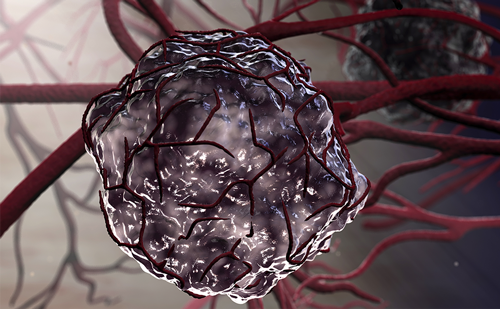The field of immuno-oncology has provided novel therapeutic agents that have led to significant improvements in patient outcomes across many tumour types. There have also been great efforts to incorporate immunotherapy (IO) into the treatment paradigms of gastrointestinal (GI) cancers. Across GI tumour types, enhanced efficacy has been seen when these agents are used in combination with other IO agents, chemotherapy and targeted drugs, and when introduced during earlier lines of treatment and in earlier cancer stages. There are ongoing efforts to select patients who are more likely to benefit from these treatments, further investigate the use of these agents in earlier stages of the disease, and enhance the likelihood and durability of response. This review will summarize the recent updates in standard practice that incorporate IO into the management of GI cancers. It will also highlight ongoing clinical studies with the potential to change standard practice.
Biomarkers for immunotherapy
Both anti-programmed cell death protein-1 (PD-1)/programmed death-ligand 1 (PD-L1) and anti-cytotoxic T lymphocyte antigen-4 (anti-CTLA-4) agents are now approved for the treatment of GI cancers. These agents remove tumour-related inhibitory signals on T-cell activation. Unfortunately, GI cancers are more resistant than other malignancies – such as melanoma and non-small cell lung cancer – to immune checkpoint inhibitors, especially when used as monotherapy. However, clinically meaningful responses have been observed in GI cancers with high microsatellite instability or deficiency in mismatch repair (MSI-H/dMMR).1–4 Current research efforts focus on identifying patients who are more likely to respond to IO treatments and to augment signals observed with IO thus far. There has been a search for biomarkers that can help identify patients who are most likely to respond to IO-based treatments to spare toxicity for those with ‘immunologically cold’ tumours and to maximize the benefits of treatments. Few biomarkers emerged as predictive for response to immune checkpoint inhibitors, but their utility is relevant to specific disease types, and their use and interpretation have significant limitations. It is important to consider the quality of data for the predictive value of these biomarkers, as well as clinical accessibility to be able to implement them in practice.
PD-L1 expression has emerged as a useful, although imperfect, biomarker to identify patients with some GI cancers who may benefit from IO. Currently, it is most relevant for patients with upper GI tumours. There are two scoring systems for PD-L1 expression: tumour positive score (TPS) and combined positive score (CPS). TPS is the percentage of tumour cells with PD-L1 staining relative to all tumour cells in the sample. CPS is more relevant in the identification of PD-L1-positive gastro-oesophageal tumours, especially adenocarcinomas. CPS is determined by the number of PD-L1-staining cells, including tumour cells, lymphocytes and macrophages, divided by the total number of viable tumour cells and multiplied by 100. Tumour spatial and temporal heterogeneity, availability of different antibodies and interpretation inconsistency challenged efficient utilization and adoption of this biomarker.5–8 Aside from upper GI tumours, the utility of PD-L1 testing to identify patients who may respond to IO has been limited.
The majority of GI cancers have a low level of microsatellite instability and/or have proficient mismatch repair protein expression (pMMR), and thus are inherently more resistant to IO.
As mentioned previously, MSI-H/dMMR tumours represent an important subgroup that must be considered for IO treatments. MSI-H/dMMR tumours have an inherently higher neoantigen burden, allowing for easier identification by the immune system, which results in better responses to IO.9 These tumours can be identified via: immunohistochemistry, to evaluate expression of mismatch repair proteins (MMR); polymerase chain reaction-based methods, to test for microsatellite instability; or testing integrated with next-generation sequencing (NGS). KEYNOTE-158 (ClinicalTrials.gov Identifier: NCT02628067) was a phase II study that demonstrated activity of pembrolizumab in a subgroup of 351 patients with advanced MSI-H/dMMR solid tumours.10,11 Pembrolizumab had clinically relevant activity in patients with non-colorectal MSI-H/dMMR tumours (overall response rate [ORR] 30.8% and median overall survival [OS] of 20.1 months).10 All GI tumours should be considered for MMR expression or MSI testing at the time of diagnosis, regardless of stage, as this can provide insight on therapy selection and prognosis, and may lead to uncovering potential germline alterations. Testing for MSI/dMMR should be performed reflexively on all advanced-stage tumours.
Tumour mutational burden (TMB) has emerged as an additional predictive biomarker for IO response.12 TMB is a quantification of the total number of somatic mutations per megabase. Similar to MSI-H/dMMR tumours, tumours with high TMB have higher neoantigen load. In a prespecified exploratory analysis of the phase II KEYNOTE-158 study, patients who had tumours with high TMB status (≥10 mutations per megabase, as defined per protocol) had a clinically relevant response to pembrolizumab (ORR 29%). Based on these results, the United States Food and Drug Administration (FDA) approved pembrolizumab in a tissue-agnostic manner for cancers with high TMB (>10).13,14 While TMB is typically available from NGS testing, its utility in clinical practice is limited. Importantly, only patients with anal squamous cell carcinoma (SCCA) and biliary tract cancers (BTC) were included in the KEYNOTE-158 trial.12 Additionally, with the exception of SCCA, most of the GI cancers with high TMB are MSI-H/dMMR.15 Therefore, it is unlikely that a significant number of additional patients whose tumours are expected to respond to immune checkpoint inhibitors will be identified using high TMB alone as a biomarker. There also remains a need to standardize this test and cutoff across different testing platforms.16
Upper gastro-oesophageal cancers
Early-stage disease
One year of adjuvant nivolumab is now standard of care in the management of oesophageal and gastro-oesophageal junction (GOJ) cancers after trimodality therapy involving chemoradiation and resection. This recent update in clinical practice is based on the results of the phase III CheckMate 577 trial (ClinicalTrials.gov Identifier: NCT02743494).17 This study enrolled 794 patients with resectable oesophageal and GOJ cancers (71% adenocarcinoma, 29% SCCA) who were previously treated with neoadjuvant chemoradiation followed by resection and had residual pathologic disease at the time of resection. Patients were randomized in a 2:1 fashion to 1 year of adjuvant nivolumab or placebo. Those treated with nivolumab had significantly improved disease-free survival (22.4 versus 11.0 months, hazard ratio [HR] 0.75), with a difference being most pronounced in those with oesophageal SCCA (OSCC) (29.7 versus 11.1 months, HR 0.61) compared with the placebo cohort. There were no unexpected treatment-related adverse events in the experimental group. Based on this trial, the FDA approved adjuvant nivolumab in this setting. Nivolumab is not indicated in patients who had complete pathologic response at the time of resection.
There remains a question about the benefit of IO for resectable gastric cancer, which is treated with perioperative chemotherapy. Ongoing phase III trials (MATTERHORN [ClinicalTrials.gov Identifier: NCT04592913] and KEYNOTE-585 [ClinicalTrials.gov Identifier: NCT03221426]) are evaluating whether addition of immune checkpoint inhibitors to chemotherapy improves clinical outcomes in these patients. There are also ongoing studies with IO and chemoradiation that are hoping to augment the efficacy signal observed thus far in CheckMate 577 (Table 1).
Table 1: Select ongoing phase III studies with immunotherapy agents in early-stage upper gastrointestinal cancers
|
Study name |
Study design |
Planned enrolment number |
NCT number |
|
Chemoradiation-based trials |
|||
|
SKYSCRAPER-07 |
Double-blind, placebo-controlled study of atezolizumab with or without tiragolumab (anti-TIGIT antibody) versus placebo in unresectable OSCC after definitive chemoradiation |
750 |
NCT04543617 |
|
KUNLUN |
Double-blind, placebo-controlled study of durvalumab with chemoradiation versus placebo with chemoradiation in patients with locally advanced, unresectable OSCC |
600 |
NCT04550260 |
|
KEYNOTE-975 |
Double-blind, placebo-controlled study of pembrolizumab versus placebo in oesophageal carcinoma treated with definitive chemoradiation |
600 |
NCT04210115 |
|
EA2174 |
Peri-operative nivolumab and ipilimumab in patients with locoregional oesophageal and GOJ adenocarcinoma treated with neoadjuvant chemoradiation |
278 |
NCT03604991 |
|
Chemotherapy-based trials |
|||
|
KEYNOTE-585 |
Double-blind study of perioperative pembrolizumab versus placebo plus chemotherapy in resectable gastric and GOJ adenocarcinoma |
1,007 |
NCT03221426 |
|
MATTERHORN |
Double-blind, placebo-controlled study of perioperative FLOT chemotherapy with durvalumab versus placebo in resectable gastric or GOJ adenocarcinoma |
948 |
NCT04592913 |
FLOT = fluorouracil, oxaliplatin and docetaxel; GOJ = gastro-oesophageal junction; ITIM = immunoreceptor tyrosine-based inhibitory motif; OSCC = oesophageal squamous cell carcinoma; TIGIT = T-cell immunoreceptor with immunoglobulin and ITIM domains.
MSI-H/dMMR tumours represent a unique subset of oesophago-gastric adenocarcinoma (OGA). In the metastatic setting, these tumours had a significant response to IO agents.18 In a retrospective analysis from the MAGIC trial, which established perioperative chemotherapy as standard treatment for patients with early-stage gastric cancer, patients with MSI-H/dMMR gastric tumours had improved prognosis and potentially worse outcomes when treated with perioperative chemotherapy.19,20 Similarly, individual patient data meta-analysis of patients with early-stage gastric cancer enrolled in the MAGIC, CLASSIC, ARTIST and ITACA-S trials demonstrated that patients with MSI-H tumours had better prognosis and did not benefit from perioperative chemotherapy compared with those who had microsatellite stable (MSS) tumours.21 Consequently, the use of IO in the early-stage setting was evaluated in two phase II studies. In the NEONIPIGA trial, 29 patients with MSI-H/dMMR gastric tumours were treated with perioperative nivolumab and ipilimumab (12 weeks in neoadjuvant setting) and had pathologic complete response at resection of 59%.22 Patients subsequently received 9 months adjuvant nivolumab. In the INFINITY trial, 9 out of 15 patients (60%) with early-stage MSI-H/dMMR gastric and GOJ adenocarcinoma who were treated for 12 weeks with tremelimumab and durvalumab (notably, only one infusion of tremelimumab was given) had complete pathologic response at resection. Prospective randomized studies are still needed before standard of care practice is updated and chemotherapy is omitted in all patients. Remaining questions include the benefit of adding chemotherapy to IO and which patients can forgo surgery.
Advanced disease: adenocarcinoma
Immune checkpoint inhibitors have an established role in the management of advanced OGA based on several landmark studies, which will be reviewed here. In the phase III randomized CheckMate 649 trial (ClinicalTrials.gov Identifier: NCT02872116), which enrolled 1,581 patients with human epidermal growth factor receptor 2 (HER2) negative EGA, the addition of nivolumab to folinic acid, fluorouracil and oxaliplatin (FOLFOX) or capecitabine plus oxaliplatin (CAPOX) chemotherapy significantly improved OS and progression-free survival (PFS).23,24 The effect was primarily seen in patients whose tumours had PD-L1 CPS ≥5 (14.4 versus 11.1 months, HR 0.69). The study also improved OS in all treated patients, which was one of the secondary endpoints (13.7 versus 11.6 months, HR 0.79). Based on these results, the FDA approved nivolumab in combination with first-line chemotherapy in advanced HER2-negative OGA irrespective of biomarker status. However, in a prespecified subgroup analysis of patients with PD-L1 CPS <5 tumours there was no observed benefit on OS with nivolumab addition (12.4 versus 12.3 months, HR 0.95). Given these data, the National Comprehensive Cancer Network (NCCN) recommends a more nuanced approach.25 Per category 1 recommendation, nivolumab in combination with chemotherapy should be reserved for those with PD-L1 CPS ≥5 tumours. Of note, the CheckMate 649 study also included a chemotherapy-free cohort, in which patients were treated with nivolumab and ipilimumab, but the median OS of 11.2 months in this group did not meet the prespecified boundary for significance.26 It is important to mention another phase III study with a similar patient population, Attraction-4 (ClinicalTrials.gov Identifier: NCT02746796). This study was performed exclusively in Asia (Japan, South Korea and Taiwan), and did not select patients with PD-L1 CPS positive tumours.27 Nivolumab addition to chemotherapy did not result in OS improvement, even though PFS was prolonged. This is possibly reflective of different medical practices across the world, incorporation of IO agents during later lines, lack of biomarker selection in the study, as well as different tumour biology across different geographic areas.
Similar to nivolumab, pembrolizumab was also evaluated in multiple phase III trials in HER2-negative upper GI cancers. The KEYNOTE-590 trial (ClinicalTrials.gov Identifier: NCT03189719) enrolled patients with both oesophageal and GOJ adenocarcinoma (27%) and OSCC (73%). This study had multiple primary endpoints, a heterogeneous patient population and multiple subgroup analyses, which makes interpretation of the results challenging. However, data from this study ultimately resulted in the FDA approval of pembrolizumab in addition to chemotherapy for the first-line treatment of oesophageal cancer based on significant OS improvement in all randomized patients (12.4 versus 9.8 months, HR 0.73). Despite broad regulatory approval, the NCCN guidelines give a stronger recommendation for pembrolizumab for PD-L1 CPS ≥10 oesophageal tumours, favouring cisplatin-based chemotherapy (category 1) over oxaliplatin (category 2a).
Most recently, results of the KEYNOTE-859 (ClinicalTrials.gov Identifier: NCT03675737) phase III trial in gastric and GOJ HER2 negative adenocarcinomas were presented at the European Society for Medical Oncology (ESMO) 2023 virtual plenary session.28 In this trial, 1,579 patients were treated with either chemotherapy alone or chemotherapy in combination with pembrolizumab. OS was improved with pembrolizumab addition (12.9 versus 11.5 months, HR 0.78) in all patients. The study population included 78.2% patients whose tumours had PD-L1 CPS ≥1. The benefit from pembrolizumab addition was largely observed in those with PD-L1 positive tumours HR 0.73 for PD-L1 CPS ≥1 versus HR 0.91 for PD-L1 CPS <1 tumours.
Immune checkpoint inhibitors are also approved for the first-line treatment of HER2-positive OGA, which represents 20% of advanced OGA.29 For this specific subtype of tumours, chemotherapy in combination with trastuzumab has been standard first-line therapy for over a decade as a result of the phase III ToGA trial (ClinicalTrials.gov Identifier: NCT01041404).30 This practice was updated after the pre-planned interim analysis of the ongoing KEYNOTE-811 trial (ClinicalTrials.gov Identifier: NCT03615326), which randomized patients to pembrolizumab versus placebo in addition to chemotherapy and trastuzumab.31 The addition of pembrolizumab significantly increased ORR compared with placebo (74.4 versus 51.9%). There were no new safety signals. The final analysis of the trial is pending; however, the early signs of clinically meaningful activity with pembrolizumab led to FDA approval, and this combination is now endorsed by the NCCN guidelines.25
In the USA, there are no IO agents that are currently approved in the late-line settings for advanced OGA. Prior studies have demonstrated limited activity of these agents when used as monotherapy for patients with pretreated OGA cancers.32,33 These studies are largely irrelevant to standard practice since they enrolled IO-naïve patients. There remains a need to improve treatments in late-line settings. Novel IO combinations should be explored, and trials should allow for prior IO use to reflect updates in standard of care.
Advanced disease: squamous cell carcinoma
IO agents are part of standard treatment for advanced OSCC. In the first-line setting, nivolumab is approved in combination with chemotherapy or in combination with ipilimumab. These approvals are based on results from the CheckMate 648 study (ClinicalTrials.gov Identifier: NCT03143153), an international phase III trial that compared these experimental combinations to standard fluoropyrimidine and platinum-based chemotherapy.34 The two experimental arms resulted in improved OS compared with chemotherapy, and the benefits in OS were quite similar with a longer follow up of 29 months (12.8 months with HR 0.78 for nivolumab and chemotherapy, 12.7 months with HR of 0.77 for nivolumab and ipilimumab versus 10.7 months for chemotherapy alone).35 It is important to note that during the first 6 months of treatment, the chemotherapy-free cohort had lower survival rates, possibly due to slower responses to IO or primary resistance to IO. Patient-specific characteristics should be considered during therapy selection, and priority should be given to chemotherapy with nivolumab in the treatment of patients with bulky disease or with significant symptomatic disease burden.
As discussed, earlier, pembrolizumab in combination with chemotherapy is an alternative option for OSCC based on the KEYNOTE-590 results. The majority of patients enrolled in this study (73%) had OSCC, and the study was powered to evaluate OS in specific subgroups, including in patients with OSCC. Pembrolizumab improved OS compared with chemotherapy plus placebo in patients with ESCC (12.6 versus 9.8 months, HR 0.72), with the most benefit observed in those with PD-L1 CPS ≥10 tumours (13.9 versus 8.8 months, HR 0.57). In addition, there have been a number of other studies, most performed in Asia, where OSCC is much more common, demonstrating similar results with IO addition and further supporting that chemoimmunotherapy should be offered in the first line to patients with advanced OSCC.36–38
Patients who do not receive IO with the first-line treatment can be considered for IO in later lines, but the benefits from IO monotherapy are limited in this setting. Both nivolumab and pembrolizumab are approved in later lines based on phase III trial results,32,39 but there is no utility of these agents for patients who are treated with IO in the first-line setting. Similar to OGA, novel IO combinations should be explored after progression on first-line therapy, and these should specifically be developed for patients with IO refractory disease.
Biliary tract cancer
BTCs are heterogeneous disorders, both anatomically and molecularly. Checkpoint inhibitors were initially investigated as monotherapy in the late-line setting, but demonstrated limited activity.40 Subsequently, a phase II study demonstrated promising activity of IO agents when combined with first-line chemotherapy.41 This led to the development of phase III TOPAZ -1 trial (ClinicalTrials.gov Identifier: NCT03875235) that evaluated durvalumab (anti-PD-L1 antibody) in combination with gemcitabine and cisplatin during first-line treatment of patients with advanced BTC.42 In this international trial, patients were randomized to either standard chemotherapy with gemcitabine and cisplatin for 6 months (following ABC-02 trial design) or chemotherapy plus durvalumab.43 Durvalumab was continued after chemotherapy was stopped at 6 months. The primary endpoint of the trial, median OS, was significantly improved in the experimental group (12.8 versus 11.5 months, HR 0.80). Although the absolute difference in OS is small, there is a fraction of patients who derive long-term benefit from the addition of durvalumab. At 24 months, the OS rate was 24.9% in durvalumab cohort versus 10.4% in the chemotherapy only cohort. The benefit from durvalumab was not restricted to biomarker-select patients, and there was a similar benefit when stratified by PD-L1 expression measured using tumour area positivity scoring. Based on these results, the FDA approved durvalumab in addition to chemotherapy in the treatment of advanced BTC and durvalumab in combination with chemotherapy has also been added to the NCCN guidelines (category 1 recommendation).25 In line with TOPAZ-1 trial results, addition of pembrolizumab to first-line gemcitabine and cisplatin chemotherapy also improved OS of patients with advanced BTC in phase III KEYNOTE-966 trial ([ClinicalTrials.gov Identifier: NCT04003636] 12.7 versus 10.9 months, HR 0.83).44 These two studies suggest that patients with BTC can derive benefit from IO, and further efforts are warranted to augment the efficacy signal observed thus far and to better identify patients who are likely to respond, specifically in considering the diversity of molecular subtypes of BTC, such as HER2 amplified, FGFR2 fusion positive, BRAFV600E BTCs. It remains uncertain if BTCs with molecular driver alterations have improved outcomes with the IO combination strategies.
Hepatocellular carcinoma
Hepatocellular carcinoma (HCC) is a chemotherapy refractory disease. For over a decade, antiangiogenic agents, such as sorafenib and lenvatinib, remained the mainstay systemic treatment for patients with advanced HCC.45,46 More recently, IO agents emerged as efficacious therapies. Initially IO were investigated as monotherapy; however, the signals in early-phase trials were not confirmed in larger phase III studies.47,48 Combination strategies have proven to be more successful. The phase III IMbrave150 trial (ClinicalTrials.gov Identifier: NCT03434379) compared the combination of atezolizumab (anti-PD-L1 antibody) with anti-angiogenic bevacizumab to sorafenib during first-line treatment of advanced HCC.49 The combination of atezolizumab and bevacizumab conferred improved PFS and a clinically meaningful benefit in OS (19.2 versus 13.4 months, HR 0.66). In addition, treatments with atezolizumab and bevacizumab resulted in a higher ORR (29% versus 11.3%), including 7.7% of patients achieving complete response. Certain molecular subgroups of tumours had better responses to this combination, including those with high expression of VEGF Receptor 2, regulatory T cells and myeloid inflammation signatures.50 Atezolizumab in combination with bevacizumab is now a standard first-line treatment for advanced HCC.
An alternative treatment option for patients with advanced HCC is a combination of tremelimumab (anti-CTLA-4 antibody) and durvalumab.51 In the global, open-label, phase III trial (HIMALAYA [ClinicalTrials.gov Identifier: NCT03298451]) 1,171 patients were randomly assigned to tremelimumab plus durvalumab (STRIDE regimen), durvalumab, or sorafenib. The STRIDE regimen led to improved OS compared with sorafenib (16.43 versus 13.77 months, HR 0.78), while durvalumab was non-inferior to sorafenib (16.56 versus 13. 77 months, HR 0.86). In all three cohorts, 36 months OS rate was 30.7%, 24.7% and 20.2%, respectively. The STRIDE and durvalumab cohorts had higher ORR (20.1% and 17%) compared with sorafenib cohort (5.1%). The rate of grade 3 and higher treatment-related adverse events was lower with durvalumab, but it was comparable between sorafenib and STRIDE regimen. As expected, most adverse events with STRIDE regimen were immune mediated. The IMbrave 150 and HIMALAYA trials established new combination IO regimens in advanced HCC. The HIMALAYA regimen should be preferentially considered in patients with contraindications to antiangiogenic agents.
Given activity in unresectable disease, adjuvant atezolizumab and bevacizumab was evaluated for localized disease in a phase III trial, IMbrave050 (ClinicalTrials.gov Identifier: NCT04102098).52 Patients with HCC with high risk for recurrence after curative intent surgical resection or ablation were randomized to treatment or active surveillance. Adjuvant therapy improved 12-months recurrence-free survival rates after a median follow up of 17.4 (78 versus 65%, HR 0.72), but the final analysis with longer follow-up is still pending.53 There are other ongoing studies in the adjuvant setting, including KEYNOTE-937 (ClinicalTrials.gov Identifier: NCT03867084) evaluating adjuvant pembrolizumab for high-risk populations after definitive local management.54 There are also studies evaluating IO agents in combination with various locoregional therapies, such as Yttrium-90 radioembolization (ClinicalTrials.gov Identifier: NCT04541173), trans-arterial chemoembolization, or stereotactic body radiotherapy (ClinicalTrials.gov Identifier: NCT04988945).
Pancreatic cancer
Unfortunately, no IO agents are approved for the management of pancreatic adenocarcinoma. Outside of MSI-H/dMMR tumours, activity of IO alone or in combination with chemotherapy has been disappointing. While a number of early-phase studies are exploring novel IO combinations and targets, as well as other ways to harness activity of immune system (such as cell therapy and tumour vaccines), none are ready for prime time or approved for clinical use.55,56
Colorectal cancer
The majority of patients with colorectal cancers (CRC) do not benefit from IO. MSS CRC has been largely resistant to IO, even when used in combination therapies. Immune checkpoint inhibitors in combination with various agents (regorafenib, lenvatinib, cobimetinib) have been explored in a number of studies (LEAP-017 [ClinicalTrials.gov Identifier NCT04776148], COTEZO IMblaze370 [ClinicalTrials.gov Identifier: NCT02788279]).57 Thus far, no clear signal of activity that exceeded standard of care was demonstrated, although IO combination may be more active in patients without liver metastasis.58 There are a number of novel agents in development, some demonstrating early signal of efficacy.59
Conversely, MSI-H/dMMR CRC have demonstrated exceptional responses to IO. In the metastatic setting, first-line pembrolizumab is the preferred treatment option for patients with MSI-H/dMMR CRC in the first-line setting. This recommendation is based on the results from the randomized phase III KEYNOTE-177 trial that compared pembrolizumab with chemotherapy. Although OS improvement was not seen with IO (likely due to IO use in later lines), pembrolizumab treatment was associated with longer PFS compared with chemotherapy (16.5 versus 8.2 months, HR 0.59).60 In addition, pembrolizumab was associated with an acceptable toxicity profile. The combination of nivolumab with ipilimumab has also been evaluated in advanced MSI-H/dMMR CRC. In the phase II CheckMate 142 trial (ClinicalTrials.gov Identifier: NCT02060188), 74 patients in the second-line setting achieved an ORR of 31%.61 The combination of nivolumab with low-dose ipilimumab in the first-line setting resulted in ORR of 69%; PFS and OS were not reached with 24 months’ follow-up.62 As a result of these studies, nivolumab with or without ipilimumab is now included in the NCCN guidelines as a treatment option for advanced MSI-H/dMMR CRC. There are ongoing first-line phase III trials with chemoimmunotherapy and IO combinations in advanced dMMR/MSI-H CRC that will hopefully help further refine therapeutic strategies (ClinicalTrials.gov Identifiers: NCT04008030, NCT02997228).
Significant activity of IO agents has been observed in MSI-H early-stage CRC. In a phase II trial that enrolled 12 patients with MSI-H/dMMR resectable rectal cancer, 6 months of dostarlimab (anti-PD-1 antibody) conferred complete clinical response in all patients.63 Similarly, in the phase II NICHE-2 trial (ClinicalTrials.gov Identifier: NCT03026140) 112 patients with early-stage MSI-H/dMMR colon cancer were treated with neoadjuvant nivolumab and ipilimumab and experienced pathologic complete response rate of 67% at the time of resection.64 The results from these phase II trials support further investigation of neoadjuvant IO in MSI-H/dMMR CRC with organ-sparing implications. It is important to note that patients with early-stage MSS colon cancer had some responses to IO combination in the phase II NICHE study as well, suggesting that tumour burden may play a role in predicting for responses to these agents.65
Anal cancer
Immune checkpoint inhibitors have demonstrated efficacy against SCCA. However, due to challenges with treatment development for rare cancers, confirmatory trials remain limited. In the late-line setting, nivolumab was evaluated in the phase II NCI sponsored trial (NCI9673) for patients with advanced SCCA.66 The trial enrolled 37 patients with previously treated SCAA. The primary endpoint of ORR was achieved in 24% of patients, with an additional 47% of patients having stable disease on treatment. The median OS in this trial was 11.5 months. The multicohort KEYNOTE-028 trial (ClinicalTrials.gov Identifier: NCT02054806) for patients with advanced PD-L1 positive solid tumours evaluated pembrolizumab in a cohort of 24 patients with SCCA.67 ORR and OS were 17% and 9.3 months, respectively. Pembrolizumab was also evaluated a larger cohort of 112 patients with advanced SCCA as part of the KEYNOTE-158 trial (ClinicalTrials.gov Identifier: NCT02628067).68 The efficacy observed was similar to prior studies with 12% ORR and 12 months OS.
IO agents are the main agents being explored in ongoing trials for SCCA, in both advanced and early-stage settings (ClinicalTrials.gov Identifiers: NCT04472429, NCT04444921, NCT03519295, NCT02314169). Given promising early results and lack of efficacious treatment options in advanced disease, nivolumab and pembrolizumab are now included as treatment options for advanced SCCA in the NCCN guidelines. Hopefully, ongoing trials will support introducing these agents during earlier stages as well.
Summary
IO agents have an established role in the management of many GI cancers. Given the modest activity of IO monotherapy for most GI cancers, combination strategies with IO should be considered. Efficacy of IO remains limited in several common cancer types, including MSS/pMMR CRC, for which no late-phase trials have conferred an improvement in survival with IO. There are a number of ongoing studies investigating the best combinations and further translational science is needed to define patients most likely to benefit from these therapies. Introduction of IO therapy in early stages or curative-intent settings should continue to be pursued given the favourable toxicity profile and higher activity in earlier disease stages. Future trial designs must incorporate novel combinations, considering both chemotherapeutic and precision-targeted strategies. Biomarker-based approaches, including those incorporating circulating tumour DNA and post-progression biopsies, are critical for the investigation of mechanisms of resistance to IO for advanced GI cancers.













